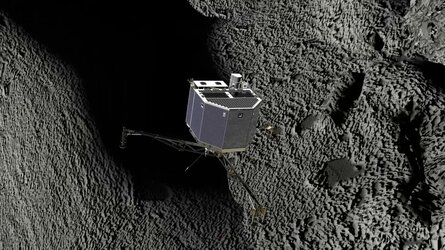Accept all cookies Accept only essential cookies See our Cookie Notice

About ESA
The European Space Agency (ESA) is Europe’s gateway to space. Its mission is to shape the development of Europe’s space capability and ensure that investment in space continues to deliver benefits to the citizens of Europe and the world.
Highlights
ESA - United space in Europe
This is ESA ESA facts Member States & Cooperating States Funding Director General Top management For Member State Delegations European vision European Space Policy ESA & EU Space Councils Responsibility & Sustainability Annual Report Calendar of meetings Corporate newsEstablishments & sites
ESA Headquarters ESA ESTEC ESA ESOC ESA ESRIN ESA EAC ESA ESAC Europe's Spaceport ESA ESEC ESA ECSAT Brussels Office Washington OfficeWorking with ESA
Business with ESA ESA Commercialisation Gateway Law at ESA Careers Cyber resilience at ESA IT at ESA Newsroom Partnerships Merchandising Licence Education Open Space Innovation Platform Integrity and Reporting Administrative Tribunal Health and SafetyMore about ESA
History ESA Historical Archives Exhibitions Publications Art & Culture ESA Merchandise Kids Diversity ESA Brand Centre ESA ChampionsLatest
Space in Member States
Find out more about space activities in our 23 Member States, and understand how ESA works together with their national agencies, institutions and organisations.
Science & Exploration
Exploring our Solar System and unlocking the secrets of the Universe
Go to topicAstronauts
Missions
Juice Euclid Webb Solar Orbiter BepiColombo Gaia ExoMars Cheops Exoplanet missions More missionsActivities
International Space Station Orion service module Gateway Concordia Caves & Pangaea BenefitsLatest
Space Safety
Protecting life and infrastructure on Earth and in orbit
Go to topicAsteroids
Asteroids and Planetary Defence Asteroid danger explained Flyeye telescope: asteroid detection Hera mission: asteroid deflection Near-Earth Object Coordination CentreSpace junk
About space debris Space debris by the numbers Space Environment Report In space refuelling, refurbishing and removingSafety from space
Clean Space ecodesign Zero Debris Technologies Space for Earth Supporting Sustainable DevelopmentApplications
Using space to benefit citizens and meet future challenges on Earth
Go to topicObserving the Earth
Observing the Earth Future EO Copernicus Meteorology Space for our climate Satellite missionsCommercialisation
ESA Commercialisation Gateway Open Space Innovation Platform Business Incubation ESA Space SolutionsLatest
Enabling & Support
Making space accessible and developing the technologies for the future
Go to topicBuilding missions
Space Engineering and Technology Test centre Laboratories Concurrent Design Facility Preparing for the future Shaping the Future Discovery and Preparation Advanced Concepts TeamSpace transportation
Space Transportation Ariane Vega Space Rider Future space transportation Boost! Europe's Spaceport Launches from Europe's Spaceport from 2012Latest

MUPUS investigations at Abydos
Thank you for liking
You have already liked this page, you can only like it once!
Summary of Philae’s MUPUS measurements at Abydos, its final landing site on Comet 67P/Churyumov–Gerasimenko. The graph at top shows the average surface temperature profile measured by the MUPUS thermal mapper, situated on the lander’s ‘balcony’. Gaps correspond to times when the instrument was not recording data. The profile shows a clear rise and fall in temperature, corresponding to lows of about –180ºC and ‘highs’ of about –145ºC in sync with the comet’s 12.4 hour day. The peaks are interpreted as infrared radiation from the directly insolated surface, with the more gentle variations outside of the peaks attributed to indirect lighting. The thermal inertia implied by the measured rapid rise and fall in the temperature suggest that the surface consists of a thin layer of dust atop a compacted dust-ice crust.
The graph at the bottom shows the hammering profile of the MUPUS penetrator. The displacement is expressed as the position of the depth sensor with respect to its starting position above the surface. An initial displacement of about 27 mm, perhaps through a thin layer of dust, is observed, followed by oscillations of 10–15 mm and smaller displacements. The reason for the lower amplitude after 80 minutes is unclear, but could indicate that the tip of the penetrator had locked to the ground. The data suggest that the instrument was hammering more or less on the spot, although not necessarily at exactly the same spot each time, with indentations of a few millimetres and recoils of up to 10 mm. The red lines indicate the power levels of MUPUS, which correspond to 0.49, 1.59, 2.17 and 4.23 joules, respectively. Discussion is ongoing as to whether the data reflect the full use of energy level 4. In any case, the results provide an estimate of the strength of the surface beneath the thin dust layer as at least 2 MPa.
-
CREDIT
Spacecraft graphic: ESA/ATG medialab; data from Spohn et al (2015) -
LICENCE
ESA Standard Licence

Instrument MUPUS misji Rosetta

Reconstructing Philae’s flight

Science on the comet

Flight over Abydos valley















 Germany
Germany
 Austria
Austria
 Belgium
Belgium
 Denmark
Denmark
 Spain
Spain
 Estonia
Estonia
 Finland
Finland
 France
France
 Greece
Greece
 Hungary
Hungary
 Ireland
Ireland
 Italy
Italy
 Luxembourg
Luxembourg
 Norway
Norway
 The Netherlands
The Netherlands
 Poland
Poland
 Portugal
Portugal
 Czechia
Czechia
 Romania
Romania
 United Kingdom
United Kingdom
 Slovenia
Slovenia
 Sweden
Sweden
 Switzerland
Switzerland

























